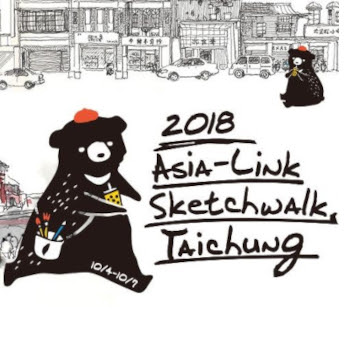 This interview with Veronica Lawlor was first published on the website of First International Urban Sketching Symposium at Portland, Oregon. Vernoica and I are the presenters for the symposium.
This interview with Veronica Lawlor was first published on the website of First International Urban Sketching Symposium at Portland, Oregon. Vernoica and I are the presenters for the symposium. Veronica Lawlor aka Ronnie, as she is affectionately called, never fails to amaze everyone with her fluid and dancing quality line work with urban landscape, figurative and festive themes. Recently, her May 11 post on Urban Sketchers which she drew New York City from a tall building in Wall Street stunned us with such genius loci, great sense of place and abstract line quality. A true New Yorker, Ronnie's interpretation of the big apple is incredibly filled with rich emotions. She always knows which parts to omit or reduce and what lines to use in all her drawings. I am also impressed with her choice of colours in some of her sketches.
I first knew Ronnie through her work on Urban Sketchers and I am excited to meet her in person during the first Internatioanl Urban Sketching Symposium at Portland this July. Coming from similar background with years of teaching under our belt, I have the following questions for her:




Understand you are one of the founders for Dalvero Academy and you also teach at Pratt Institute and Parsons School of Design. What is your view on the relationship between art and design and how they should compliment each other?
To me, art and design are synonymous. You can’t have a good design without art and I can’t imagine a piece of art without design. As a teacher I love drawing because it reveals the truth of the artist’s own sense of design. Drawing reveals where a student’s strengths lie: fashion, architecture, sculpture, painting, film, illustration, photography, you name it. And then drawing helps them to get there. It’s the tool of the artist and also like a crystal ball to their future.
When I search for “reportage drawings”, your name appears everywhere on the results. What is reportage drawing and why do you think reportage drawing as an art genre is important?
The word reportage comes from the French, meaning ‘the act or process of reporting’. Reportage drawing can be journalistic or descriptive of place and can carry the artist’s opinion. Since it is painted or drawn and not photographed, reportage illustration can take liberties with ‘reality’ in order to be clearer in meaning. It is important to the art genre because it is a direct artistic response to a place or situation, right there on the spot, and it becomes very instinctive. In that it is different from the majority of artistic experience that involves the artist alone in a studio working.
Since there is a direct connection between the artist’s hand, eye and mind, it can be very emotional as well. Reportage is so rewarding for me because I love it as a way to interact with the world and contribute.
You are the author for several books and your works are exhibited in galleries and museums. Can you tell us more and what these achievements mean to you in your role as artist, illustrator and educator?
The gratifying thing about having my work published and in gallery or museum settings is that I am able to reach the public with it. To me, art is always about communication with people. When my drawings of September 11th were exhibited at the Fire Museum in New York City, I had firemen coming up to me with tears in their eyes telling me how emotionally affected they were by seeing them. That kind of emotional connection is such a big part of the reason why I started drawing in the first place. I can be a bit shy at times, but I’m really an extrovert at heart, and drawing allows me to reach out to people who I might otherwise never come in contact with.
You are the only artist to draw, on the spot, the 9/11 attacks on the World Trade Center, share with us the emotion and how did you manage to go through the wreckage to do the reportage. Was it tough and how did you recover from it?
The attacks on the World Trade Center were such an unbelievable source of grief for New Yorkers. Many of us (myself included) lost friends or family that day; all of us lost the World Trade Center. I have lived my entire life in New York City; those buildings are alive to me. Every day when I look up and see the Empire State Building and I feel like I’m home. The World Trade Center was the same.
I was in shock when I was making those drawings, but it felt like the right thing to do. Documenting what was going on was a way to work through my emotions, both during and after the attack. Over the next few months I drew and drew everything that was going on. It gave me a purpose and made me feel as if there was something I could contribute in a situation where the reality was that I was powerless over it.




more drawings by Veronica on 911 here
As one of the Board Directors for Urban Sketchers, what do you wish to see at the upcoming Symposium in Portland?
I hope that the symposium will promote the art of drawing on location and bring its practitioners from all over the world together. There’s nothing better than being with a group of people that have the same love that you do. And I hope this symposium will be the beginning of many more!
 • Veronica's blog.
• Veronica's blog.• Veronica's website.
• Veronica's drawings.







![Logo _Jan20_version7 [Converted]](https://farm9.staticflickr.com/8736/16890205286_287a880265_z.jpg)





![logo _jan20_version7 [converted]](https://3.bp.blogspot.com/-jnCyt1l7sqA/W1OwtH4hi8I/AAAAAAAADqg/uH2Dcev0cIwdKAP4DEK-yKGenrvsrO1DACK4BGAYYCw/s1600/amsterdam.png%20width=)
![logo _jan20_version7 [converted]](https://2.bp.blogspot.com/-TJN-9_HqvLw/WJy7vqSb0uI/AAAAAAAAGOg/jqVfu3S51dgLcC1yC5X-HUTxENqbCvkoACLcB/s1600/Chicago2017_FINAL-01.jpg%20width=)




